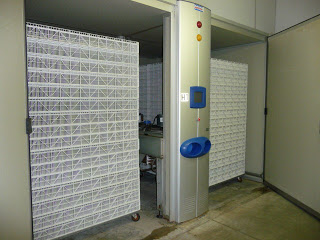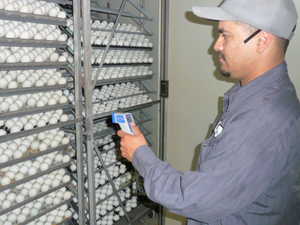Friday, June 3, 2011
Most of you have incubators that have several different ages of eggs in them. And you have your incubator set to one constant temperature. Right? What I learned the other day is you want one constant temperature during incubation. But not the incubator temperature - the shell temperature!
Last Friday we were visited by Jerry Garrison and Phillip Percy, technical advisors from Jamesway, the company that built our new Incubators. Jerry told me they are learning that the shell temperature is the important temperature, not incubator temperature. And the reason you want to know the shell temperature is that closely follows the temperature of the embryo which should be stable throughout incubation.
We have single stage incubators for our duck and goose eggs, which means all the eggs in that machine are set to hatch on the same day. We start the incubator temperature at 100.3 and by the time they start hatching it is set at 98.2. But he said if we measured the shell temperature, it should always read about 100.2!
Last Friday we were visited by Jerry Garrison and Phillip Percy, technical advisors from Jamesway, the company that built our new Incubators. Jerry told me they are learning that the shell temperature is the important temperature, not incubator temperature. And the reason you want to know the shell temperature is that closely follows the temperature of the embryo which should be stable throughout incubation.
We have single stage incubators for our duck and goose eggs, which means all the eggs in that machine are set to hatch on the same day. We start the incubator temperature at 100.3 and by the time they start hatching it is set at 98.2. But he said if we measured the shell temperature, it should always read about 100.2!

Why does the shell temperature differ from the incubator temperature? Initially the embryo is very small and not generating any measurable heat. But the egg shell is cooler than the incubator because small amounts of moisture are evaporating from the shell which cools it - just as our sweat cools us. This water loss is normal as an egg loses 13-14% of its weight during incubation.
However, as the embryo grows, it starts generating more and more heat. Eventually it is producing so much heat that it's shell temperature can be two degrees warmer than the air in the incubator. The egg is warming the surrounding air - not vice versa.
So how do you know the shell temperature of incubating eggs? You can get a infrared thermometer. You can get inexpensive one for only $60 but they do not measure in 1/10's of a degree. To measure as accurately as necessary you need to spend several hundred dollars.
However, as the embryo grows, it starts generating more and more heat. Eventually it is producing so much heat that it's shell temperature can be two degrees warmer than the air in the incubator. The egg is warming the surrounding air - not vice versa.
So how do you know the shell temperature of incubating eggs? You can get a infrared thermometer. You can get inexpensive one for only $60 but they do not measure in 1/10's of a degree. To measure as accurately as necessary you need to spend several hundred dollars.

The best way to maintain a constant shell temperature is to have a single stage incubator (only one age of eggs in the incubator). To have a shell temperature of 100.2, you need it to be 100.3 in the beginning and then gradually reduce it until it is about 98.2 when they start hatching. For more information on single stage incubation, click this link and select the third article.
If you are used to setting every week, how do you switch to single stage incubation? You would need at least two incubators and set eggs every two weeks. Your first egg set of the spring would be in one incubator. Ten to fourteen days later (10 days if you are setting chicken eggs, 14 for ducks) you set all your eggs in the second incubator. By rotating your egg set from one incubator to the other, you have created two single stage incubators! Just be sure the incubator is capable of sufficient ventilation to cool itself when it is full of older, heat producing embryos.
The biggest advantage of the multi-stage incubator is that it is easy. The disadvantage is the embryos will be slightly cool early in the incubation and slightly warm late in incubation.
I found the idea of a constant embryo temperature fascinating - and how that varies from the incubator temperature. Do any of you have experience measuring shell temperatures or using single stage incubation?
If you are used to setting every week, how do you switch to single stage incubation? You would need at least two incubators and set eggs every two weeks. Your first egg set of the spring would be in one incubator. Ten to fourteen days later (10 days if you are setting chicken eggs, 14 for ducks) you set all your eggs in the second incubator. By rotating your egg set from one incubator to the other, you have created two single stage incubators! Just be sure the incubator is capable of sufficient ventilation to cool itself when it is full of older, heat producing embryos.
The biggest advantage of the multi-stage incubator is that it is easy. The disadvantage is the embryos will be slightly cool early in the incubation and slightly warm late in incubation.
I found the idea of a constant embryo temperature fascinating - and how that varies from the incubator temperature. Do any of you have experience measuring shell temperatures or using single stage incubation?